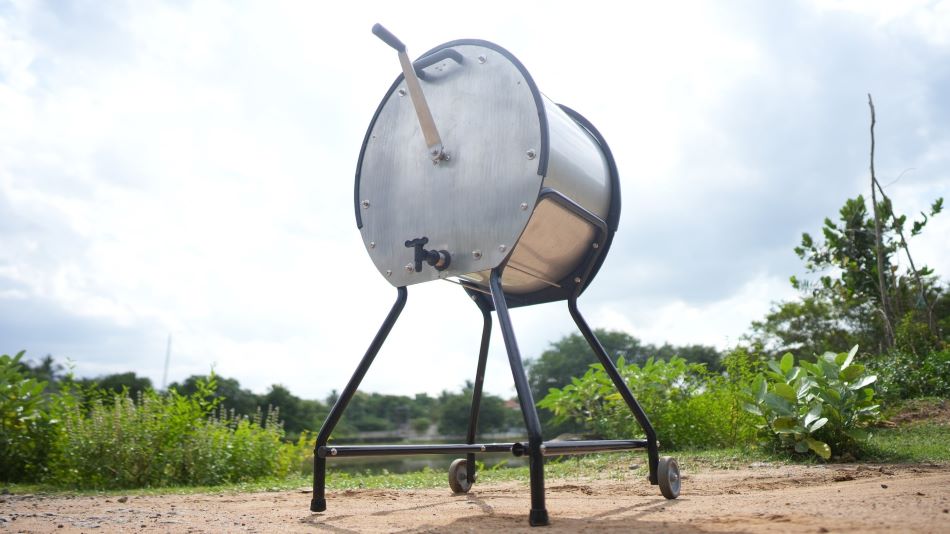Hand-Cranked Washing Machine Helps Underserved Communities
Hand-Cranked Washing Machine Helps Underserved Communities


The Washing Machine Project delivers stainless steel units that run without electricity and very little water all around the world.
Anjali runs a tea stand in South India and used to wake up at 3:00 a.m. every day to walk in the heat to a heavily contaminated local pond to wash her family’s clothes. She would then return home to start her 12-hour working day. But the gift of the Divya washing machine from The Washing Machine Project changed Anjali’s life for the better. The Washing Machine Project is a United Kingdom-based grassroots organization that aims to alleviate the burden of handwashing clothes and empower people like Anjali “by providing remote, low income and displaced communities with an accessible, off-grid washing solution.”
“Anjali has enough water to wash her clothes at home so she doesn't have to travel to the pond, and she can focus on the tea stand that she runs,” said Navjot Sawhney, the organization’s founder.
After quitting his job at Dyson in the U.K., Sawhney moved to a small South Indian village, where he discovered that his new neighbor Divya was spending a lot of time and effort hand-washing clothes. When Sawhney suggested he would buy Divya an electric washing machine, she responded that she didn’t have enough water for the machine nor a generator that could provide backup electricity if the power went off.
“It was a penny drop moment for me,” Sawhney said, realizing the challenges people like Divya faced. The burden of hand-washing clothes predominantly falls on women and girls, who spend up to 20 hours per week on this chore. In 2019, Sawhney launched The Washing Machine Project to address the problem. The solution: A washing machine named after his neighbor.
A standard-issue salad spinner provided inspiration for the first iteration of the washing machine. Working with a research team based in the University of Bristol, Sawhney extensively researched user behavior, asking: How do they wash clothes? Where do they get water? Where do they get soap? How much clothes does each family need washed?
Find Solutions for Sustainable Development Like This in the Engineering for Change Solutions Library
“The pain points always came down to three things: Too much water, too much time, and a lot of effort that lead to backache, joint pain, and skin irritation,” Sawhney said.
So, the team drew up a long laundry list of requirements: The machine needed to have a large drum to accommodate a large capacity of clothes (5-10 kilograms, enough for a family) and be water-efficient. It needed to be recyclable, run without electricity, and be easy to maintain.
The final stainless steel product is a direct-drive machine—a drum inside a drum. “We wanted the machine to have horizontal access for water efficiency, but top-loaded, so you don’t get any of the leak paths,” Sawhney said. It works without electricity on manual cranking. “We tried different form factors, different modes of operation, and that’s how we settled on the crank handle. Previous iterations were geared. Now it’s not geared,” Sawhney said.
The Divya washing machine is shipped flat-packed. Also: “If something breaks, people can fix it using off-the-shelf parts—you can take it apart with two tools and a spanner, and you can put it back together,” Sawhney said.
Discover the Benefits of ASME Membership
Divya sits on a tubular frame with wheels, which provide light portability. A handle connects through a shaft, straight through the drum, to the three lifters that lift and agitate the clothes. Users pour 30 liters of water into the drum and can use almost any kind of detergent, including grated bars of soap. A wash cycle lasts for 30 minutes. The clothes need to soak for 10 minutes to let the detergent do its job. Users then manually turn the machine for a few minutes and repeat the process three times. A load takes about six minutes of manual turning time. When the cycle is done, a tap draws water out of the inner tub for disposal.
Early challenges have revolved around scaling the production of the machines. “We were designing and manufacturing these machines and redistributing small-scale pilots in multiple locations around the world,” Sawhney said.
A partnership with The Whirlpool Foundation, the non-profit arm of the Whirlpool Corporation, helped address the scale challenge. “Over the last year, we've gone from making one Divya washing machine a day to making one every five minutes. And that kind of scale up has really helped us ramp up the distributions, and most importantly, the impact, saving 75 percent of time and 50 percent of water compared to hand washing clothes,” Sawhney said. Employees from the Whirlpool Corporation volunteer their time to build the washing machines.
 Distribution of the Divya machine is targeted for underserved populations in rural and urban areas in India, Mexico, Brazil, the Republic of Congo, Kenya, and Uganda. “We have impacted over 30,000 people's lives across 13 countries,” Sawhney said.
Distribution of the Divya machine is targeted for underserved populations in rural and urban areas in India, Mexico, Brazil, the Republic of Congo, Kenya, and Uganda. “We have impacted over 30,000 people's lives across 13 countries,” Sawhney said.
The focus, he added, is on frugal innovation. The Whirlpool Foundation makes the machines free for recipients. Future goals include developing drying options for washed clothes as well. The Divya machine is just the tip of the iceberg.
“In the future, there will be multiple products and services linked to machines and tools that make the lives of people like Divya and Anjali easier,” Sawhney said.
Poornima Apte is a technology writer based in Walpole, Mass.
“Anjali has enough water to wash her clothes at home so she doesn't have to travel to the pond, and she can focus on the tea stand that she runs,” said Navjot Sawhney, the organization’s founder.
After quitting his job at Dyson in the U.K., Sawhney moved to a small South Indian village, where he discovered that his new neighbor Divya was spending a lot of time and effort hand-washing clothes. When Sawhney suggested he would buy Divya an electric washing machine, she responded that she didn’t have enough water for the machine nor a generator that could provide backup electricity if the power went off.
“It was a penny drop moment for me,” Sawhney said, realizing the challenges people like Divya faced. The burden of hand-washing clothes predominantly falls on women and girls, who spend up to 20 hours per week on this chore. In 2019, Sawhney launched The Washing Machine Project to address the problem. The solution: A washing machine named after his neighbor.
Divya’s early iterations
A standard-issue salad spinner provided inspiration for the first iteration of the washing machine. Working with a research team based in the University of Bristol, Sawhney extensively researched user behavior, asking: How do they wash clothes? Where do they get water? Where do they get soap? How much clothes does each family need washed?
Find Solutions for Sustainable Development Like This in the Engineering for Change Solutions Library
“The pain points always came down to three things: Too much water, too much time, and a lot of effort that lead to backache, joint pain, and skin irritation,” Sawhney said.
So, the team drew up a long laundry list of requirements: The machine needed to have a large drum to accommodate a large capacity of clothes (5-10 kilograms, enough for a family) and be water-efficient. It needed to be recyclable, run without electricity, and be easy to maintain.
The final stainless steel product is a direct-drive machine—a drum inside a drum. “We wanted the machine to have horizontal access for water efficiency, but top-loaded, so you don’t get any of the leak paths,” Sawhney said. It works without electricity on manual cranking. “We tried different form factors, different modes of operation, and that’s how we settled on the crank handle. Previous iterations were geared. Now it’s not geared,” Sawhney said.
The Divya washing machine is shipped flat-packed. Also: “If something breaks, people can fix it using off-the-shelf parts—you can take it apart with two tools and a spanner, and you can put it back together,” Sawhney said.
Discover the Benefits of ASME Membership
Divya sits on a tubular frame with wheels, which provide light portability. A handle connects through a shaft, straight through the drum, to the three lifters that lift and agitate the clothes. Users pour 30 liters of water into the drum and can use almost any kind of detergent, including grated bars of soap. A wash cycle lasts for 30 minutes. The clothes need to soak for 10 minutes to let the detergent do its job. Users then manually turn the machine for a few minutes and repeat the process three times. A load takes about six minutes of manual turning time. When the cycle is done, a tap draws water out of the inner tub for disposal.
Partnership with The Whirlpool Foundation
Early challenges have revolved around scaling the production of the machines. “We were designing and manufacturing these machines and redistributing small-scale pilots in multiple locations around the world,” Sawhney said.
A partnership with The Whirlpool Foundation, the non-profit arm of the Whirlpool Corporation, helped address the scale challenge. “Over the last year, we've gone from making one Divya washing machine a day to making one every five minutes. And that kind of scale up has really helped us ramp up the distributions, and most importantly, the impact, saving 75 percent of time and 50 percent of water compared to hand washing clothes,” Sawhney said. Employees from the Whirlpool Corporation volunteer their time to build the washing machines.

Guiding Innovators on the Journey to Market
The ASME Innovation Showcase is a global accelerator of hardware-led social innovation open to entrepreneurs taking physical products to market that will have a positive social impact.
The focus, he added, is on frugal innovation. The Whirlpool Foundation makes the machines free for recipients. Future goals include developing drying options for washed clothes as well. The Divya machine is just the tip of the iceberg.
“In the future, there will be multiple products and services linked to machines and tools that make the lives of people like Divya and Anjali easier,” Sawhney said.
Poornima Apte is a technology writer based in Walpole, Mass.






